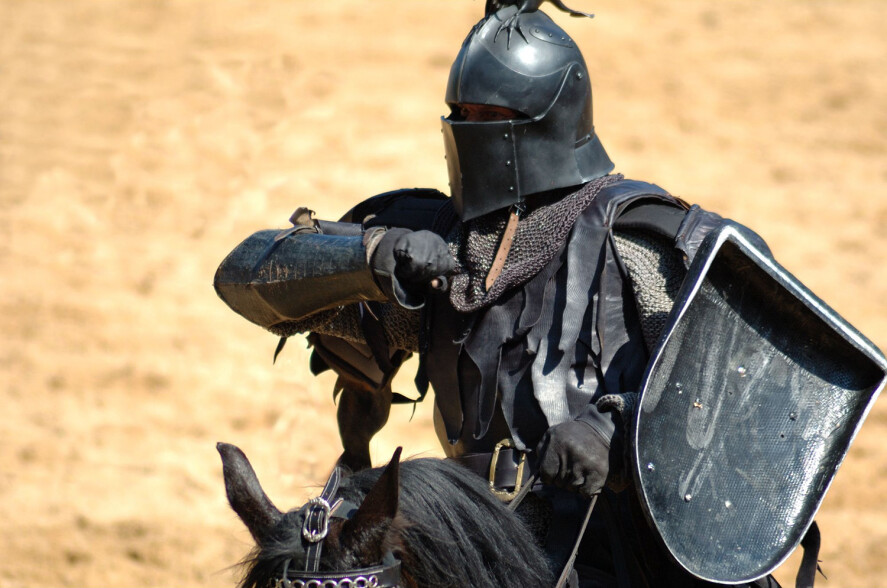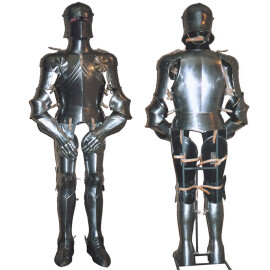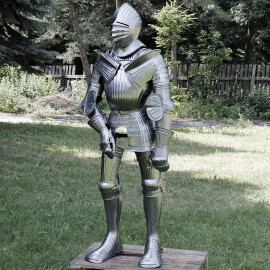Medieval Plate Armour Makers: Forgotten Craft, or an Opportunity?

It would seem that the golden age of the makers of plate armour has ended with the emergence of firearms. However, the craft has not completely disappeared. What changes has armour making process undergone since the earliest times? Why are people still interested in historical armour? Read on to find out more about excellent plate armour makers (not only) in the Czech Republic!
Contents
It all began with historical fencing...
The year 1989 is considered to be a turning point in the modern history of armour making in the whole central Europe: old crafts, including armour making, began to flourish again.
Surprisingly (or maybe not so surprisingly), it was historical fencing that reignited the interest in historical armour and related crafts. More and more people became interested in the hobby known as Historical European Martial Arts (HEMA). It offered an escape from everyday life and a peek into the history.
DID YOU KNOW... that the oldest existing fencing club “Riegel” was founded in the Czech lands in 1902? It was named after its first master, Lieutenant
Dominik Riegel (1840-1920).
The real golden age of historical fencing started at the turn of the millennium: between 2000 and 2005. Demand for historical weapons and clothing, footwear, jewellery or armour and other replicas skyrocketed. In the following years, due to the unceasing demand, many smaller craftsmen began to focus on the production of historical items.
Little is Known About the Original Craft
The craftsmen of today, however, had to face a problem that the historical armourers didn’t: the information about the production process of plate armour was long forgotten, and the information available was scarce. Brief reports were found by attentive researchers in the old chronicles and other historical sources, but even that information was not enough.
But the craftsmen did not give up so easily. Not discouraged by the lack of available information, they decided to rely on their own inventiveness and skills. And so, several centuries after the last production of historical plate armour, the craftsmen began reinventing the long forgotten techniques and processes of armour making. Old crafts were reborn, old techniques were again put to use, only with modern materials.
DID YOU KNOW... medieval battles have both older and younger fans? Learn more about medieval armour for children that will allow young aspiring knights to experience a bit of European past!
Every experienced armourer must know the historical development of plate armour in order to determine which plate armour will be the best fit for the given purpose and required era.
The History of Armour Making: From Antiquity to the Modern Era
The manufacture of plate armour has undergone rapid development since its beginning. This is a brief overview of the armour making process in different historical eras:
1. Antiquity
The oldest surviving depiction of warriors wearing metal helmets dates from the Sumerian period, between 3500-1950 BC. From the later Egyptian or Persian Empire, an armour made of bronze scales attached to leather has been preserved.
A significant technological development of metal armour occurred in the ancient Greece era. Infantry (foot soldiers) called hoplites used the armour type called cuirass, protecting their chest and back. Their heads were protected with heavy bronze helmets, and their legs were covered with bronze shin guards, called greaves.
In Ancient Rome, the poorer members of the army used not only chainmail and scale armour, but sometimes also iron armour. The last mentioned type consisted of overlapping metal plates. We know this armour under the name “plate armour”. One of the earliest form of it used by the Roman legionaries was called lorica segmentata (which literally means “segmental body armour”).
Plate armour gradually became dominant armour used by the army.
2. The Middle Ages
Middle Ages brought development in technologies and more efficient metalworking, and specialised professions that dealt with the production of armour began to emerge.
Blacksmithing began to split and specialize, forming various sub-crafts, such as:
- Swordsmiths
- Girdlers (the makers of girdles, belts)
- Chainmail makers (armourers)
- Plate armour makers (armourers)
Plate armour makers started to turn into a very important and busy industry in the 14th century. During this time, plate armour gradually replaced chainmail, at first by local additions to elbows, knees, and shins, until it eventually became a complete armour covering full body.
DID YOU KNOW... Many people believe that plate armour restricted movement and was very heavy. But that is not entirely correct. A full set of plate armour weighed around 20 kilograms, which is far less than the soldiers have to carry today. Also, because the weight was distributed evenly over the torso, head and limbs, mobility was quite good.
In the late Middle Ages, full plate armour was at its peak. That was for mainly two reasons:
- Infantry soldiers were increasingly important. Nobility on horseback was no longer the decisive unit of the army. Instead, infantry was becoming the main force, able to achieve tactical objectives and determine the victor of battles. However, large numbers of foot-soldiers needed adequate armour and weapons, which was not easy to supply.
- Due to the significant development of bows and crossbows at this time, it was necessary to improve armour so that it could stop crossbow arrows. For this reason, chainmail armours were reinforced with metal plates for more protection.
Metal plates replaced materials previously used to reinforce armours, such as leather and chainmail.
The most important armouries and blacksmith workshops were located in:
- southern Germany (Augsburg, Landshut and Nuremberg),
- northern Italy (Milan),
- Tyrol (Innsbruck)
In addition to those, workshops offering cheaper armour emerged throughout Europe, accounting for approximately 70% of total armour production. These workshops did not aim at top-notch quality and materials, but rather at the lowest price and affordability for large number of people.
3. Early Modern and Modern Era
The rapid development of firearms in this period ultimately changed the nature of warfare (not only) on European battlefields. Plate armour and other types of medieval armour gradually disappeared from the battlefields.
Many metal armours were “recycled” into items of everyday use. Luckily, some pieces of armour were saved and preserved by private collectors, and their value is priceless today.
In the 19th century, people's interest in the Middle Ages gradually revived, and historical armour became an artifact and a reminder of the ancient times, attracting a lot of admirers, collectors as well as scholars. Various replica makers emerged to meet the growing demand. Preserved armours are displayed in historical castles and in museums.
DID YOU KNOW... Many pieces of plate armour had a unique name, for example greaves (ankles and calves), sabatons (feet), poleyns (knees), cuisses (thighs), gauntlets (hands), vambrace (lower arms), pauldron (shoulders), and the list goes on.
A Short Historical Overview:
The Decoration of Plate Armour - Luxury or Necessity?
Although the primary purpose of plate armour was to protect the warrior during battle, it also “represented” him and indicated his social status. Some armours for wealthier warriors were sometimes gold-plated, silver-plated, with engravings or forged with various other metals. These modifications did not increase the level of protection, they merely showed the high status of the wearer.
Rulers and members of wealthy families spent considerable sums of money on getting an ornate armour.
The plate armour of the Duke of Milan, Lodovico il Moro (1452-1508), was said to be worth three villages or five hundred cows!
However, the most impressive plate armour known was the armour of King Henry VII. (1491-1547). It was constructed for use both on horse and on foot, however, he had to be hoisted onto his horse, because the armour weighed 180 kilograms.
The plate armour makers did not do the decorations themselves. In order to serve wealthy and demanding customers, they usually hired specialists to do the decorating job for them.
Plate Armour Makers in the Czech Republic
Despite the growing interest in replicas of historical armour at the beginning of this millennium, we can see a declining trend in the recent years. Interest in the craft of plate armour making has been slowly declining, despite the fact that experienced armourers receive more orders than they can handle.
This is mainly because people are often buying plate armour in other countries, especially India - one of the biggest producers of plate armour today. No other producers in other countries are able to supply goods in such quantities as the Indian producers, which is why Indian producers receive the large orders for film industry.
DID YOU KNOW... the German auction house
Hermann Historica offers the possibility to compare the prices of replicas with the price of original items? The house specializes in the valuation and sale of original historical weapons and armour.
In the Czech Republic alone, there are about 10 blacksmith workshops specializing in the production of plate armour. Companies Klepáč, Brožka or Nádvorník are the most famous of them. Their replicas are exported both to other European countries (Germany, Italy, France...) and overseas (Australia, USA).
Where to Buy a Plate Armour
If you want to get a plate armour for yourself, there are a few options:
- Visit a second-hand shop online. If you are looking for cheaper alternatives, browse online second-hand stores for used historical items.
- Search on Facebook There is a large community of people interested in replicas of historical armour and weapons on social media. Check out the company profiles and groups of your local plate armour makers, LARP fans or collectors of historical items!
- Shop in verified online stores. Our shop offers high-quality replicas of plate armour, as well as plate gauntlets, helmets and other parts of armour.
- Contact the manufacturers of plate armour directly. Choose a specific armour workshop and order your custom-made armour. However, expect a long delivery time. You will probably have to wait for a few months.
Do you know a verified plate armour maker in your country that you can recommend to others? Share your experience with other readers and leave a comment below!








Comments